Branding with Rooftop Logos
Roofing Contractors Make Their Mark Visually on Projects
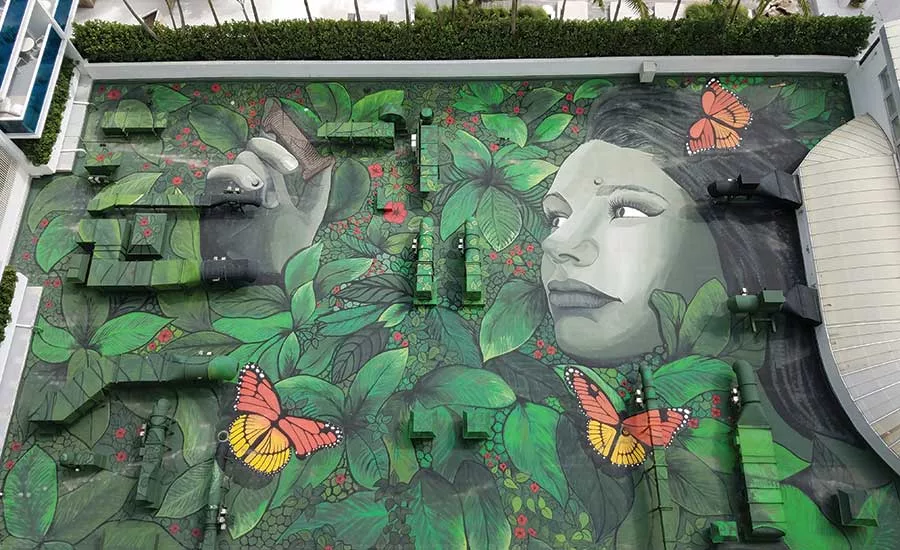
This mural covering the entire roof of the 1 Hotel in Miami Beach used coatings from Tropical Roofing Products and was installed by artist Dean “Zeus” Colman in early 2016. Photo courtesy of Dean “Zeus” Colman, Zeus Art.
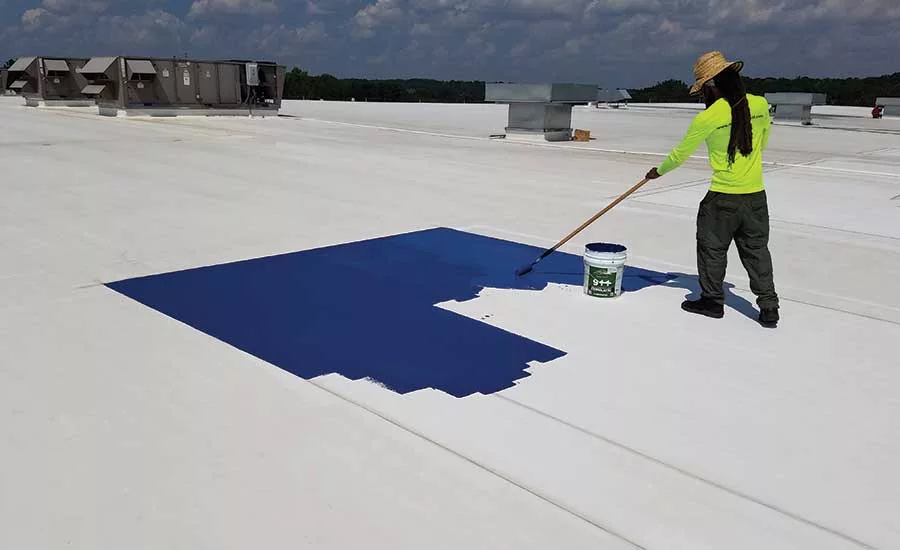
A durable roof coating is applied to a rooftop logo project on a warehouse in Atlanta. Photo courtesy of Tropical Roofing Products.
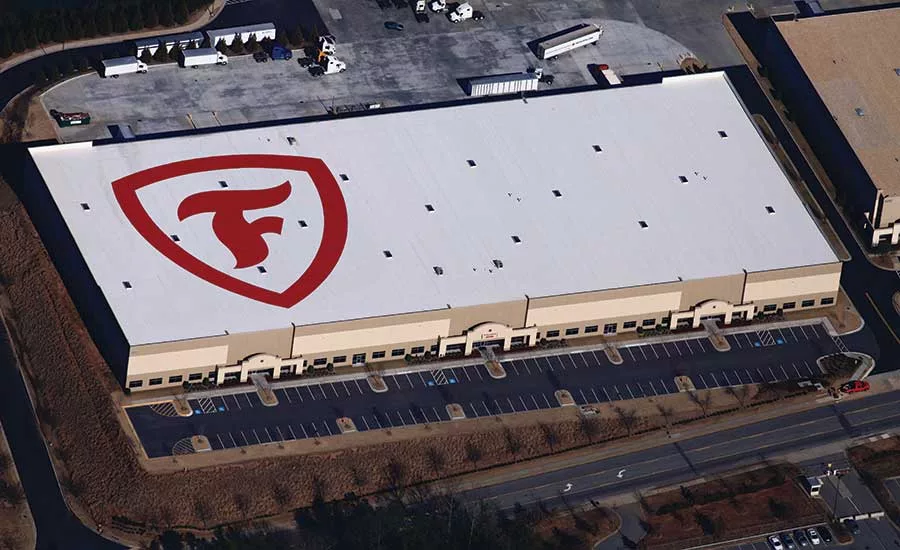
The Firestone “F-shield” logo atop this Firestone metal plant in Atlanta was created using a compatible, durable primer to bond a roof coating material to the fully-adhered Firestone TPO Roofing System. Photo courtesy of John Larimer, Firestone Building Products.
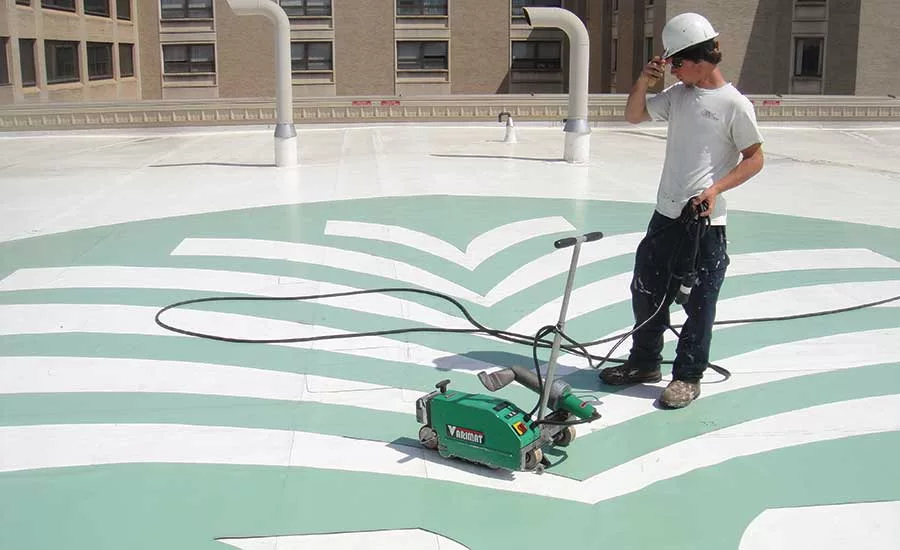
The Greenville, S.C., Healthcare System logo in patina green PVC was installed on a Sika Sarnafil PVC Roofing System in 2014 by Lloyd Roofing in Greenville. Photo courtesy of Charlie Lloyd, Lloyd Roofing.
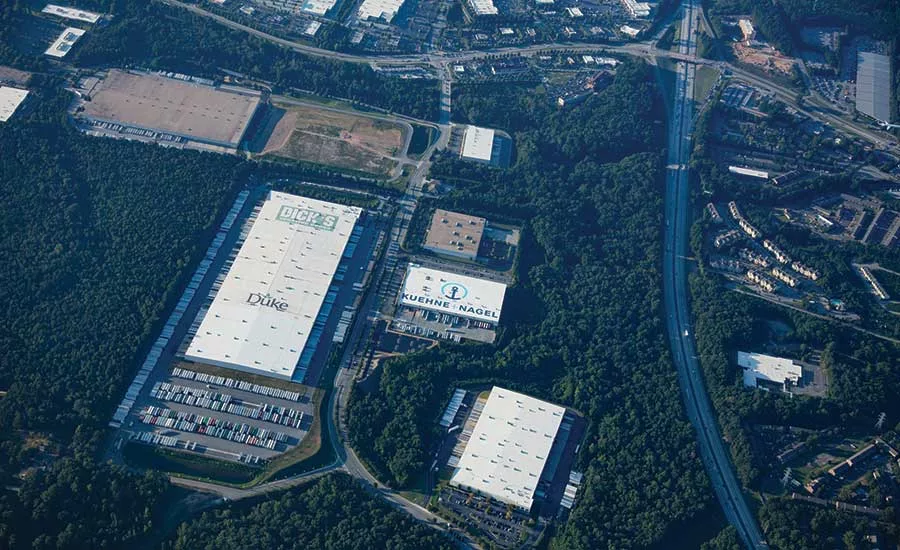
In 2007, Mid-South Roof Systems, of Forest Park, Ga., installed a GAF TPO roof on a new 500,000 square-foot warehouse owned by Duke Realty. Both the Duke Realty and Dick’s logos were added using GAF’s TopCoat product. Photo courtesy of RoofLogos.com and Mid-South Roof Systems.
From coast to coast, roofing contractors are continually tasked with installing large commercial roofing systems. Licensed contractors are accustomed to following manufacturer’s guidelines and understanding limitations and codes related to specific materials, while also procuring a warranty. Imagine also being asked to add a logo design or art to a rooftop. This might be a tall order for some, but not for a group of experienced roofing contractors who’ve embraced this challenge.
There are several important installation considerations for rooftop logos and designs. While there are designs on shingled roofs and ballasted systems, for this story, we’ll focus on single-ply commercial roofing systems where logos highlight the building owner’s brand image.
Roofing system design expert Tom Hutchinson, principal of Hutchinson Design Group, Ltd., of Barrington, Ill., noted that anyone involved with installing a rooftop logo should have a solid knowledge of roofing and roof warranties.
“The incorporation of a rooftop logo as part of the roofing solution is a unique opportunity for many building owners,” he said. “As with any type of roof top additive, the logo design should be well thought out and consideration of not only climatic conditions but (other elements).”
For example, contractors should ask questions like ‘Will aircraft exhaust or expressway effluent mar the logos effectiveness and colors?’
“They should be designed and detailed to be part of the roof system, be part of the manufacturer’s roof-system warranty and be installed and maintained appropriately by qualified roofing contractors,” Hutchinson added.
Historic Arena
Placed on the National Register of Historic Places in September 2014, the iconic Los Angeles Forum is a multi-purpose indoor arena in the suburb of Inglewood, Calif. In its 50-plus year history, the building has served as the home of the L.A. Lakers, site of the 1984 Summer Olympics basketball games and countless other sporting and entertainment events. Closed for renovation from 2012-13, it reopened as a world-class concert venue with a capacity of 17,500.
ADCO Roofing & Waterproofing, of North Hollywood, Calif., bid for the Forum reroof project through general contractor Clark Construction after the existing built-up roof was removed. ADCO replaced it with a new PVC roof system as designed by BBB Architects of Toronto.
“Part of the project was the installation of a logo on the PVC roof cover,” said Andrew Triphon, vice president of ADCO.
Manufacturer Sika Sarnafil was directly involved with the designers to develop the logo. Once the design was finalized, ADCO purchased the materials from Sika. “What was delivered in material for the logo was way beyond what we imagined,” he recalled. “It came in about 200 pieces of cut and custom colored PVC,” he said.
The size of the logo was roughly one-third of the overall roof, and even though it came with a map, Triphon said they hired a surveyor to plot the entire area to accurately place the pieces where they belonged.
“This was new for us and the biggest challenge was fitting the pieces together,” he said.
Following the surveyor’s outline, ADCO went to work. The word “Forum” was the point of focus and had to be perfectly straight, with each letter in multiple pieces because they were so large. The other words, “Chase” and “Bank,” were individual pieces. Triphon said the installation was like any other PVC adhered roof system: The membrane was laid in place and adhered with Sika adhesive and seams were heat welded together to create one complete, uniform section. The Chase Bank Forum roofing system has a 30-year warranty.
“After we finished the project, we received tickets to an Eagles concert from the building owner,” Triphon said. “We sent members of our crew as a thank you for all their hard work on the project. This was a high-profile job and one we certainly are proud of.”
Local Emblem
Local and regional brands are also making their way to the rooftop. For example, the logo of Greenville Health System was adhered to an existing PVC roof on the Greenville Memorial Medical Campus in Greenville, S.C. Charlie Lloyd, vice president of Lloyd Roofing in Greenwood, S.C., said this three-year project involved a cutting vendor who crafted a logo from Sika Sarnafil patina green colored PVC. Lloyd Roofing installed the roof in phases from 2010-12, then came back in 2014 to install the logo.
“This was our first logo, so it was a challenge,” Lloyd explained. “We received a diagram and the green material from the manufacturer. We knew it was coming in pieces, but we didn’t know there would be 40 pieces.”
Dimensions were 45 feet in diameter. One of the manufacturer’s tech reps talked to the building owners and they wanted to have the logo in an area with the least amount of penetrations.
“First, we found the agreed-upon starting place, then laid out the design and went to work,” Lloyd recalled. The logo membrane was adhered with adhesive, then the seams were heat welded to create the unified logo.
Worldwide Brand
When approaching the Atlanta International Airport by air, you may see the symbol of a well-known global brand on an expansive flat white roof. The Firestone “F”-shield logo was applied in the fall of 2008 when Firestone Building Products opened its metal manufacturing facility on the Southwest side of Atlanta.
A Firestone fully-adhered TPO roof was installed by Atlas Roofing and the logo was installed by Larimer/Shannon Group, both of Atlanta. Larimer/Shannon Principal John Larimer shared the challenges that came with the logo installation, including the use of special layout and design tools to provide the exact scale and dimensions of the F-shield logo.
In addition to the aforementioned single-ply membrane materials, roof coatings are also used to create roof top logos and designs. “In the case of the F-shield, we used a compatible, durable primer to bond a roof coating material to the TPO membrane, all within parameters of the warranty. Allowing for extra drying time in between coats was critical,” Larimer noted. “And at the same time, we had to comply with the corporate logo standards, correct PMS colors and all design elements.” PMS stands for Pantone Matching System, which is a proprietary color system used in a wide variety of industries. Originally designed for printing, PMS is also used in the coloring of paint, fabric and plastics. Pantone color guides are used today by artists, designers, printers and now roofing and coatings manufacturers for accurate color identification, design specification and quality control.
An important factor in the longevity of roof logos is exposure to the elements. “We make sure our building owner customers understand there will be fade,” Larimer said. “Darker shades of royal blue and deep red will lose color, so a touch-up between five and 10 years after the initial installation may be required.” Weather, dew point and temperature are also key considerations.
Knowledgeable Partners
“Part of the success of rooftop logo application lies in the ability to provide an exact logo as approved by the company the logo represents. You shouldn’t just go paint something on a roof,” Larimer said. A professional advertising, marketing or logo application firm should be involved and someone with knowledge of roofing warranty impact is essential. Roof Logos.com is a company with just the kind of expertise Larimer refers to. “We have a checklist of requirements,” said RoofLogos.com Director of Business Development Jeff Ansel. “People generally aren’t aware of what goes into this process, so we work directly with the end user for what they want.”
One of RoofLogos.com’s first projects came in 2007, with Mid-South Roof Systems, of Forest Park, Ga., as the installer.
Around the same time, Mid-South installed a GAF TPO roof on a new 500,000 square-foot warehouse owned by Duke Realty. The Duke Realty logo was added to that rooftop using GAF’s TopCoat product. “Once we finished the Duke logo, Duke’s tenant Dick’s Sporting Goods was interested as well,” said Mid-South Estimator Kyle Brown. Within a few months, the Dick’s logo joined the Duke logo on that same facility.
The coatings Mid-South uses are elastomeric based and include products from manufacturers such as Tropical Roofing Products and GAF. And advancements are consistently introduced to the market. “We recently were asked to quote a Sherwin Williams fluoropolymer coating, which is now being used because it’s fade resistant,” he said.
Mid-South’s success with roof top logos takes a couple of important facts into consideration. First, new TPO roofs should naturally cure out in the elements. Brown said this increases the effectiveness of the coating’s adhesion. “If the roof is a year or older, we follow manufacturer instructions for cleaning and prepping the surface before applying the coating for the logo. Also in the case of a new TPO roof, applying primer first is necessary for optimum adhesion and a successful application.”
One of Mid-South’s newest roof logo projects was completed in the summer of 2016. They installed a new Firestone TPO roof on another warehouse property for Duke Realty. Working with Tropical Roofing Products, Mid-South applied a logo for Duke’s tenant Kuehne & Nagel, a global logistics company.
The sales of applying rooftop logos are made at a high level by the building owners and tenants. “Building owners drive the decision, not the manufacturers,” Brown noted. Fees associated with this kind of advertising opportunity fall above and beyond costs incurred for creating a rooftop logo, such as materials, coatings or design.
RoofLogos.com’s Ansel advises customers to keep their requests simple. “In many cases, we can do things with lots of details and intricate patterns, however, it raises the price considerably and gradient fills and blending are not available. We’ve had some interesting requests, including cartoons,” he noted. “Surprisingly, we can go over roof top units for HVAC heating but skylights pose a particularly challenging obstacle to a logo design. Careful design and placement of the image can avoid the issue in most cases, although I believe, with further development, a technical solution could be found if the skylights can’t be avoided.”
RoofLogos.com offers a 10-year warranty for their logos, but Ansel said they usually last longer. “In the case of existing roofs, we encourage our customers to look at the roof’s age and life expectancy because the logo could outlast the roof. They’re investing their dollars, so we want to help them achieve their goals.”
As a key partner with Mid-South Roof Systems and RoofLogos.com, Florida-based Tropical Roofing Products is a manufacturer of fluid applied roof restoration solutions. “Most of our work is in repairing, preserving and restoring roofing systems for single-ply, BUR, Mod Bit and metal roofing systems, as well as foam and structural concrete substrates,” said Keith Borden, Tropical’s Gulf Coast district sales manager, “The roof logos aspect of our business began in partnership with Mid-South Roof Systems in 2007, but we’ve offered custom colored coatings for many years.”
Borden points to a strong relationship with contractors as a key to Tropical’s success. “They know they can trust us because we offer a couple of advantages — compatibility with many different roofing surfaces and our coatings are easy to match to PMS colors,” he said. Since contractors know that Tropical’s products help preserve roof systems and that they are compatible with the substrates of the roof surface, they also discovered Tropical’s coatings would work for other applications like logos and designs.
Tropical Roofing Products manufactures and packages water-based and silicone-based versions of custom-colored coatings. “While we produce several different chemistries, many of the logo coatings are water-based, LVOC and compatible with a wide variety of roof surfaces,” Borden said.
Tropical also is considering their silicone-based product for roof logos. “We look at the conditions of the existing roof membrane and what will give us the best performance,” he said.
With weather conditions a key consideration for logo application, water-based products may not be the best choice in cold climates. The silicone-based products can be applied at either low or high temperatures successfully, Borden explained, and silicone also offers more waterproofing characteristics and lower permeability.
The coloring process can be the most difficult part of the equation, Borden explained.
“Since we deal with digital files, we get a specific PMS color. The Pantone system is a ratio of several different colors put together to create an exact tint for that specific PMS color.”
So, in the case of Dick’s Sporting Goods green color, what may be the right color in a liquid form won’t necessarily look the same when dry. “Particularly when we are dealing with dark colors. To be sure, we provide the client with a dried sample and a quart of the colored coating to make sure that it is perfect,” he said.
Once approved, Tropical creates a batch of the coating, which may be as small as 50 or as large as 1,500 gallons. “That way we know that the color is uniform and just what the customer is expecting. Every case is different and every budget is different. We try to match those to have the best result,” he added.
In the case of a new or existing roof under a manufacturer’s warranty, Tropical works in conjunction with that manufacturer to make sure all specifications are met between the coating and the existing membrane. “We certainly don’t want to compromise the roof, but want to make it last even longer,” Borden said.
Beyond Logos – Rooftop Art
One of Tropical Roofing Products’ most interesting projects goes beyond a logo design, to an actual work of art. In late 2015, London-based artist Dean “Zeus” Colman was commissioned to create an 80 x 130 ft. mural to camouflage the ventilation systems on the third-floor rooftop of the boutique 1 Hotel in Miami Beach. “I designed this piece to coincide with the tropical, natural theme of the hotel and its surroundings, using a grid system that I then transferred to the rooftop,” Colman explained. He took leaf samples from trees near the hotel and shared those with Tropical Roofing Products to develop the base color to tie in with the environment.
Tropical developed different colors for Colman to use as he worked to create all the designs within the roof surface. The mural includes many colorful leafs, foliage, and butterflies to properly cover the vents, and a large portrait of a woman’s face in contrast to the plants, to further draw attention from roof penetrations.
“I knew it would be very difficult to create this piece without it washing away in the rain or drying instantly from the heat before I could blend it for application,” Colman said. He experimented with a variety of other exterior paint type products, but said he found the Tropical’s were the best to use. “They assured me their products would be the most suitable for this type of job and went to work to create an exterior base color for the first step of the mural,” Colman said. “Tropical’s coatings were great to use. I worked with large rollers to lay the coating out and even with the constantly changing weather, it rolled on smoothly and consistently and dried fast enough not to be ruined by rain.”
One year after he completed the design, he visited the 1 Hotel to make some adjustments to the piece. “I reconnected with Tropical, who kept the mural’s color palette on record and were happy to produce more coating for me. I’m thrilled to see that the color has held up incredibly for such bright colors. I’ve painted countless murals in my life but this piece has held up the best because I used what I believe to be the best product available.”
From practical branding strategies to works of art, Larimer said he sees rooftop logos as a growing trend for commercial building owners. “I think this is the new advertising space of the next two decades,” he said.
Looking for a reprint of this article?
From high-res PDFs to custom plaques, order your copy today!




